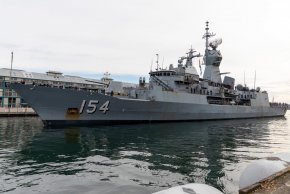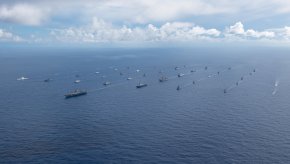Meh - nothing wrong with that.
I firmly believe that Defence needs to be more public when needed. If there are questions like this that can be answer with unclassified data then they should be. And if we cannot explain it, then perhaps our actions aren't quite right.
Asking such questions and doing such interactions can only make us better. I've said before, but queries and points from these forums have been fed in at high levels - simply because of questions that we haven't been able to answer properly. Keep asking, poking and prodding.
I guess part of my thinking is what is a realistic amphibious load out for a given operation.
In particular an operation independent of a major ally like the US.
Also the necessity to factor in the reality, that with only three amphibious ships,100% availability will always be a challenge.
For HADR and light military contingency's I can understand aviation assets will be modest in number.
Space for stores , vehicles and personnel will be the priority.
Moving up the threat spectrum, I wonder what a realistic mix of aviation / vehicle and stores would look like within a given space.
.................................................................................................................................
I'll paint a scenario and would be interested in some feedback.
The need is to land a force with vehicles and supply's overseas within our region.
We have air cover from the RAAF, but it is at distance. ( We are an Island, everything is shaped by distance)
The politics is cold war today, but potentially hot war tomorrow, We go prepared for the worst case scenario.
We have drawn a line in the sand so are committed to the task at hand.
The challenge is a submarine threat, but limited surface forces or opposition air power.Land forces are modest.
My hypothetical force is from what we have and what I suspect would be available at a moderate level of notice.
Maybe two amphibious ships.
Four frigates / destroyers
A supply ship.
Aviation
My understanding is the aim is to have (8) x MH-60R's for service, which I understand was a typical compliment for the RN off their carriers to provide a meaningful ASW screen 24 / 7.
Logistical support, at least one on the supply ship and each Amphib. (3 )
Suggest at least one operational Chinook for heavy lift, with a spare to provide availability.(2 )
An operational flight of 4 MRH-90 would require at least another 2 for a spare and short term servicing (6)
These would need to be escorted, so suggest a pair of ARH Tigers, which would also need a spare and another for short term servicing (4 )
If the math is correct, that is 23 helicopters.
Realistically, I feel these are very conservative numbers.
With the potential to carry a total of 6 helicopters on the supply ship and frigates, the rest will need to be accommodated on the Amphibs.
HMAS Choules has modest capacity, so maybe two aircraft, leaving the balance carried by the LHD, which would be 15 Aircraft.
So what is this force we wish to land I hear you ask.
Well realistically its whatever we can accommodate within the remaining space.
Hypothetical scenarios are always opens to many "what if's" and debate on creditably re a given situation.
What I'd truly like to be considered re aviation at sea, is what is the driver in an amphibious operation.
Chicken or egg if you like
Is it the space to accommodate the land force or is it the Air Power require to both land, supply and protect that force.
Maybe it's an obvious question, but it reflects my interest and sense of priority in building up our skill set of deploying helicopters to sea in good numbers.
Thanks for reading
Cheers S


